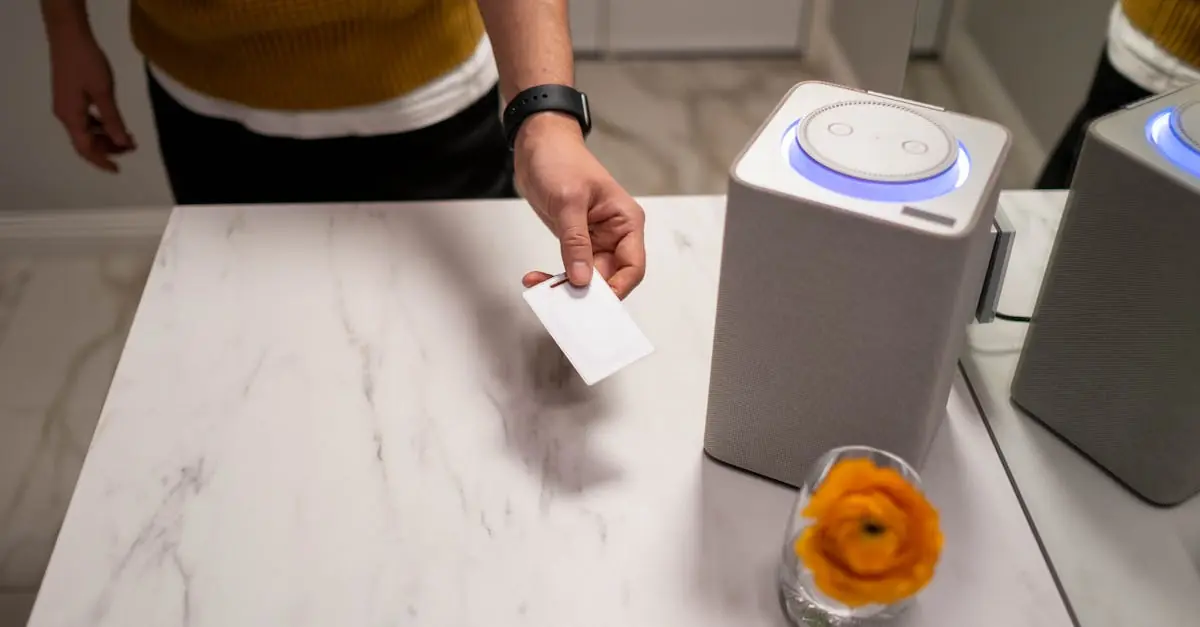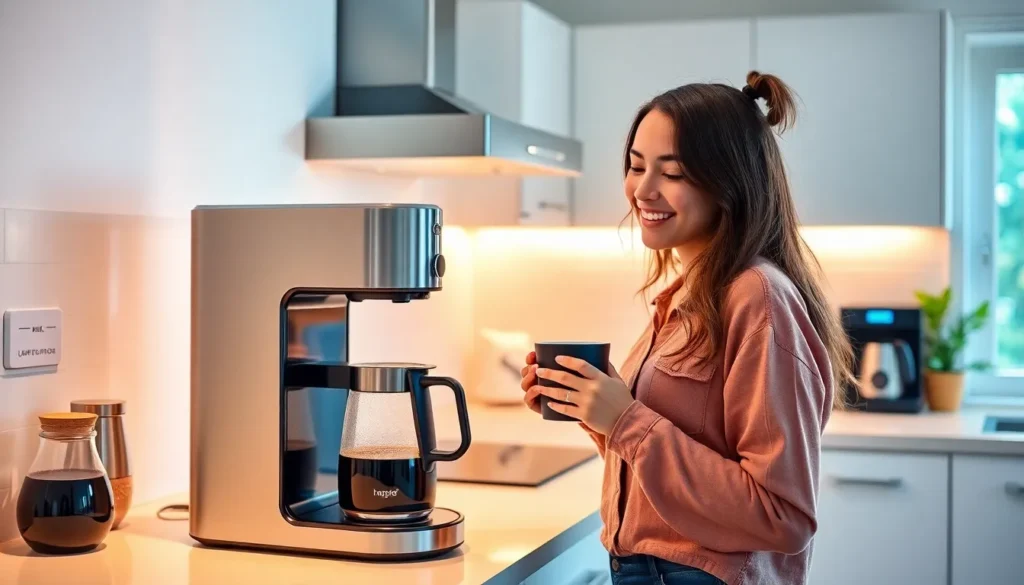Imagine walking into your home and having the lights turn on, the thermostat adjust, and your favorite playlist start playing—all without lifting a finger. Sounds like magic, right? Welcome to the world of smart home automation, where convenience meets innovation. It’s not just for tech enthusiasts anymore; it’s for anyone who wants to turn their home into a futuristic haven.
Table of Contents
ToggleUnderstanding Smart Home Automation
Smart home automation refers to the integration of technology into home systems for enhanced control and efficiency. This technology connects various devices, allowing them to communicate and function together seamlessly.
What Is Smart Home Automation?
Smart home automation involves the use of devices that can be controlled remotely via a smartphone or computer. Examples include smart thermostats, security cameras, and intelligent lighting systems. These devices create a connected home environment that enables users to monitor and manage their household efficiently. By employing sensors and automation protocols, the system can adjust settings based on user preferences or routines.
Benefits of Smart Home Automation
Smart home automation offers numerous advantages. Increased convenience stands out as a primary benefit, allowing homeowners to manage their environment instantly. Enhanced energy efficiency comes from programmable settings that optimize power usage, significantly lowering utility bills. Improved security features like remote surveillance and automatic alerts provide peace of mind. Additionally, customizable settings cater to individual lifestyles and preferences, creating a personalized living space.
Preparing for Installation
Preparing for smart home automation installation involves several key steps to ensure a smooth process. The right preparation can enhance functionality and user experience.
Assessing Your Home’s Compatibility
Assessing compatibility between your home’s existing systems and smart devices is crucial. Consider the age of wiring, type of connections, and current technology used. Older homes may require upgrades for optimal performance. Smart devices often depend on Wi-Fi connectivity, so evaluate signal strength in different rooms. Identify any dead zones that might disrupt network connectivity, and determine if a mesh network is necessary. Lone devices can hinder automation, while comprehensive compatibility supports seamless integration.
Choosing the Right Devices
Choosing the right devices impacts the efficiency and effectiveness of your smart home. Prioritize essential devices based on needs and daily routines. Look for devices that complement each other, such as smart thermostats paired with sensors for energy management. Research brands and models for features like remote control, voice activation, and compatibility with platforms like Amazon Alexa or Google Assistant. Read reviews and consider user experiences to find reliable products. Selecting devices that sync together enhances overall automation, creating a cohesive system tailored to individual preferences.
Installation Process
Smart home automation installation involves several steps, whether done independently or with professional assistance. Understanding installation options helps ensure an efficient setup that meets specific needs.
DIY vs. Professional Installation
DIY installation offers flexibility and cost savings. Homeowners find detailed instructions provided by manufacturers for many smart devices, guiding them through setup. However, professional installation ensures expertise and convenience. Trained technicians handle complex systems, reducing the chance of errors. Homeowners who lack technical skills may prefer the reassurance that comes from hiring professionals. Weighing the pros and cons helps individuals make an informed choice based on their comfort level and the complexity of the system.
Step-by-Step Installation Guide
Begin by gathering equipment and tools needed for the installation. Identify the location for your devices, ensuring they have a strong Wi-Fi connection. Next, connect smart devices to the power source and follow the manufacturer’s setup instructions carefully. After connecting devices, download the accompanying mobile app for management. Configure settings according to personal preferences, enabling automation features such as scheduling and remote control. Lastly, test each smart device to confirm they function correctly and integrate seamlessly into your home network. Ensuring everything works together guarantees an optimal smart home experience.
Post-Installation Considerations
Post-installation considerations play a vital role in ensuring a seamless smart home experience. Homeowners must address important aspects like network setup and security.
Setting Up Your Smart Home Network
Setting up a robust smart home network is crucial for maximizing device functionality. Ensure high-speed Wi-Fi is available throughout the home by using a mesh network if necessary. Position the central router in a central location to improve coverage. Add repeaters or extenders to boost signal strength in distant areas. Prioritize devices that require stable connections, such as smart security cameras and thermostats, for reliable operation. Regularly check for firmware updates on the router and devices to maintain security and performance.
Ensuring Security and Privacy
Ensuring security and privacy is essential when implementing smart home automation. Change default passwords for all devices to strengthen security. Utilize strong, unique passwords for each device and enable two-factor authentication when available. Keep software up to date to protect against vulnerabilities. Monitor connected devices and limit access for guests or family members. Consider setting up a separate Wi-Fi network for smart devices to enhance security. By taking these steps, homeowners can safeguard their smart home environment from potential threats and maintain privacy.
Troubleshooting Common Issues
Smart home automation can face various issues. Understanding these common problems enhances the user experience.
Connectivity Problems
Connectivity issues often disrupt smart home systems. Weak Wi-Fi signals may hinder devices’ performance. Placing the router in a central location improves signal strength. Mesh networks can provide better coverage throughout larger homes. Regular router reboots can enhance connectivity. Checking for firmware updates on the router and devices also proves beneficial. Wireless interference from appliances can lead to disconnection. Prioritizing devices that require stable connections resolves many issues. Assessing and adjusting network settings may eliminate recurring problems. Implementing these actions promotes seamless interaction among devices.
Device Compatibility Issues
Device compatibility presents potential hurdles in automation. Not all smart devices function together seamlessly. Researching device specifications before purchase ensures better integration. Families should favor devices from the same ecosystem, like smart hubs or platforms. Updated firmware versions can improve cross-device functionality. Conflicting protocols often lead to challenges; for instance, Zigbee and Z-Wave might not communicate effectively together. Utilizing a universal hub can bridge gaps between different systems. Familiarizing oneself with supported devices enhances overall performance. Choosing long-term compatible devices optimizes the automation experience.
Embracing smart home automation can significantly elevate daily living. With the right devices and installation approach homeowners can enjoy unparalleled convenience security and energy efficiency. Whether opting for a DIY setup or hiring professionals the key lies in understanding individual needs and ensuring compatibility for a seamless experience.
Post-installation attention to network security and device management is crucial for maintaining a robust smart home environment. By following best practices and staying informed about updates homeowners can protect their investment and enjoy the full benefits of automation. Ultimately a well-implemented smart home system not only enhances comfort but also transforms a house into a truly modern living space.




